
Exhibitions: Current | Upcoming | Past
Exhibitions: Past
Rooted in Memory
Yary Livan Pete Pin Amy Lee Sanford LinDa Saphan Savonnara Sok
September 5 – October 11, 2019
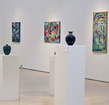

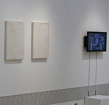
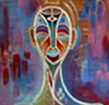
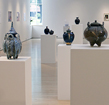
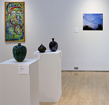
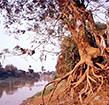
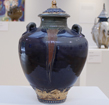
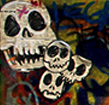

The Gallery reopens on September 5 with the exhibition called Rooted in Memory. The show features the work of Yary Livan, Pete Pin, Amy Lee Sanford, LinDa Saphan, and Savonnara Sok. Rooted in Memory, encompasses ideas about exile, displacement, and loss. It also an acknowledgement of the persistence of cultural identity and the touchstones that exist beyond geographical boundaries.
The work in this exhibition connects to a number of ideas.
How do we honor our history when we no longer have access to the geography in which our familial roots were planted?
What does it mean to be stateless?
What does it mean to be a survivor? Or a refugee in a new country?
How do we define home?
The exhibition is the first curatorial effort by our staff assistant, Rathary Kranh. The show has long been in the making. Rathary is a graduate of Bristol's Graphic Design transfer program and she has been working with the gallery for
more than a decade. She designed and maintains our website. She oversees the design of promotional and interpretive materials for each of our exhibitions. She also works with our work-study interns each year to introduce them to the professional practice of design.
Kathleen Hancock
Director
Roots are not in landscape or a country, or a people, they are inside you. —Isabel Allende
My first memory of the Grimshaw-Gudewicz Art Gallery is from a class visit in 2007. It was opening night and I remember walking in and feeling intimidated by the space and all the people in the gallery. As I walked around the room, I found myself lost and in awe of the artworks. Suddenly, the noise from the crowd diminished and my feeling of intimidation was gone.
The exhibition was LUSH, a textile exhibition of works made by many different artists. There were fabrics arranged from ceiling to floor and the textiles reminded me of my father. For all my life my father worked as a weaver. He would bring home some of the samples he worked on and I was always amazed by the beautiful fabrics.
As I left the art gallery I thought of the wonderful experience I just had. I never thought about the art gallery again, until the opportunity for an internship came up. I was excited for the chance to gain work experience but I was nervous about what the job would entail.
Over the years, I 've learned a lot about the curatorial process and exhibition planning and when Kathleen approached me about curating an exhibition for the gallery, I knew immediately what I wanted to do. I told her about my idea to develop an exhibition of work that would be about my Cambodian roots. This project is a way for me to honor my culture and to connect the gallery to the Cambodian community.
The Cambodian genocide was carried out by the Khmer Rouge regime under the leadership of Pol Pot, and it resulted in the deaths of approximately 1.5 to 2 million people from 1975 to 1979, nearly a quarter of Cambodia 's population.
This genocide focused on eradicating intellectuals and artists. Based on Communist Party ideology their goal was to build an agricultural utopia called "Year Zero."1
The destruction left an enormous wound in Cambodia's heritage. In the decades since, a vibrant art scene has re-emerged as a way to heal and reckon with the horrific past and move forward. This new generation of artists look beyond the
traditional images and motifs. Yet their works acknowledge the unique culture and experiences of Cambodians, and at the same time celebrate the rebirth of a new generation.
Rathary Kranh
Curator
1Wikipedia contributors. "Cambodian genocide." Wikipedia, The Free Encyclopedia. Wikipedia, The Free Encyclopedia, 22 Aug. 2019. Web. 23 Aug. 2019.
For more infomation about the Cambodian Genocide.
Artists
Yary Livan
Yary Livan is a ceramist and artist who currently lives and works in Lowell, Massachusetts. He is one of only three Cambodian master ceramists known to have survived the Khmer Rouge genocide of 1975. Primary targets of the Pol Pot regime were artists, writers, and intellectuals. Mr. Livan managed to survive by applying the clay and kiln-building skills he had learned as a student to manufacture roof tiles. He was granted political asylum in 2002. His work and teaching focus on traditional Khmer ceramic forms and ornament. He has been honored as an NEA National Heritage Fellow, the highest honor the US bestows for folk and traditional arts. He teaches at the Western Avenue Studios in Lowell.
Pete Pin
Pete Pin was born in the Khao-I-Dang refugee camp on the border of Cambodia and Thailand in 1982 and was raised as a refugee in California. His photo-based work explores themes of memory, migration, and intergenerational trauma among the Cambodian American community across the United States and among his own family in the U.S. and Cambodia. Previously a high school drop-out, Pin is a graduate of the University of California at Berkeley, where he did Honors and was awarded the Louis and Charles Outstanding Honors Thesis Award, and the International Center of Photography. He received fellowships and grants from the Magnum Foundation and Open Society Foundations Photography Project, among others, and has been featured in the New York Times, TIME Magazine, NPR, and VICE, among others.
Amy Lee Sanford
Amy Lee Sanford is a sculptor whose work investigates the intersection of trauma and healing, the healing processes of repetition, recollection and repair, and the defragmentation of history. Born in Phnom Penh, Cambodia and raised in the United States, the artist holds a degree from Brown University in the Visual Arts. Sanford has been in numerous exhibitions internationally, most recently Break, Bind and Rebuild (Kuala Lumpur, 2018), UnAuthorized Medium (Amsterdam, 2018), Memory | Commitment | Aspiration (Arkansas, 2018), Cinerama: Art and the Moving Image (Singapore, 2017–18).
LinDa Saphan
LinDa Saphan was born in Phnom Penh, Cambodia. Fleeing the Khmer Rouge regime, she lived for more than two decades in Canada and France. In 2005, she co-founded Visual Arts Open in Phnom Penh and established the "Selapak Neari" program in 2006, providing workshops, networking opportunities, and an exhibition space for emerging artists. As a visual artist, Dr. Saphan's work has been included in several collective exhibitions throughout Cambodia, Myanmar, Kenya, Hungary, Singapore, France, and the US. She earned a PhD in Sociology from the Sorbonne in 2007. Saphan is also an associate producer and head researcher for the documentary film directed by John Pirozzi Don't Think I've Forgotten: Cambodia Lost Rock and Roll released in 2014. The film tracks the twist and turns of the political turmoil of Cambodia's modern history through the lens of rock and roll. She is currently an Assistant Professor of Sociology at the College of Mount Saint Vincent.
Savonnara Sok
Born in Long Beach, California, where his Cambodian parents came to escape the Khmer Rouge genocide, artist Savonnara Alexander Sok says one of his early and enduring influences was his grandfather, a monk at the local temple. When he was 12, Sok's family moved to Omaha, Nebraska, and it was there that he began to develop and explore art making. Although he studied Graphic Design at the University of Nebraska, his work explores the role of spirituality in his life and influences such as street or urban art. He incorporates found materials and his work exudes exuberance. The themes most important to him are life, death, and love. He currently lives and works in Providence, Rhode Island.

